Passengers (2013) 174.7 million | ||
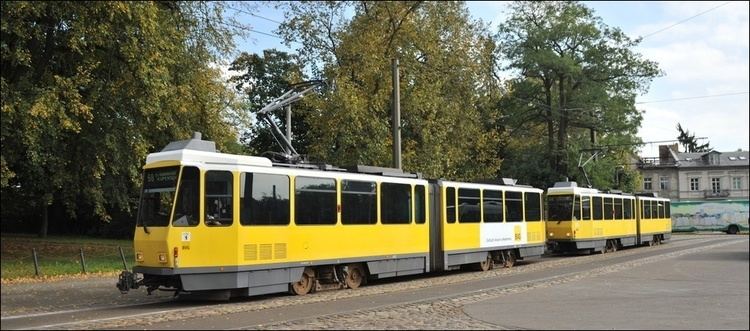 | ||
Operator Berliner Verkehrsbetriebe (1929–, BVG) | ||
The Berlin tramway (German: Straßenbahn Berlin) is the main tram system in Berlin, Germany. It is one of the oldest tram networks in the world having its origins in 1865 and is operated by Berliner Verkehrsbetriebe (BVG), which was founded in 1929. It is notable for being the third largest tram system in the world, after Melbourne and St. Petersburg. Berlin's streetcar system is made up of 22 lines that operate across a standard gauge network, with almost 800 stops and measuring almost 190 kilometres (120 mi) in route length and 430 kilometres (270 mi) in line length. Nine of the lines, called Metrotram, are operated 24 hours per day, and are identified with the letter 'M' before their number; the other thirteen lines are regular city tram lines and are identified by just a line number.
Contents
- History
- Horse buses
- Horse trams
- Electrification
- Underground trams
- Great variety of companies until the formation of the BVG
- The network since 1945
- West
- East
- After Reunification
- Lines
- Fleet
- GT6N
- Flexity Berlin
- Tram depots
- General view
- References
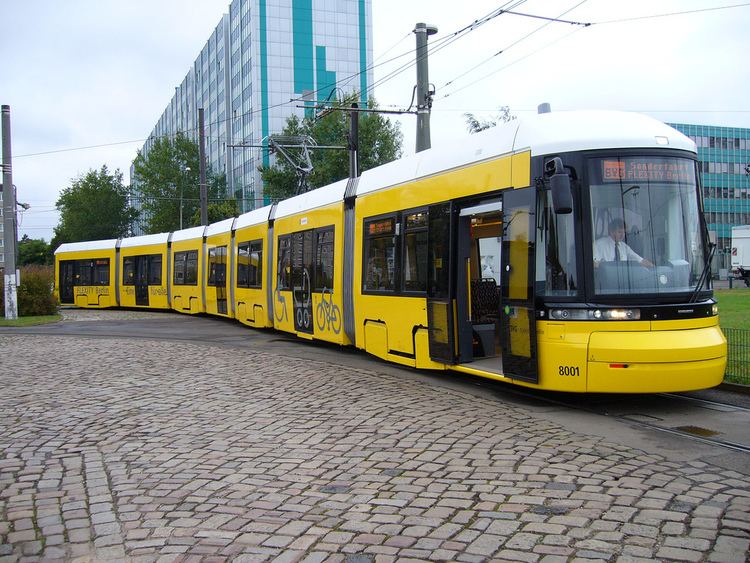
Most of the recent network is within the confines of the former East Berlin—tram lines within West Berlin having been replaced by buses during the division of Berlin (the first extension into West Berlin opened in 1994 on today's M13). In the eastern vicinity of the city there are also three private tram lines not part of the main system, whilst to the south-west of Berlin is the Potsdam tram system with its own network of lines.

History
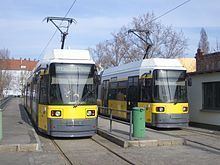
In 1865, a horse tramway was established in Berlin. In 1881, the world's second electric tram line opened. Numerous private and municipal operating companies constructed new routes, so by the end of the 19th century the network developed quite rapidly, and the horse trams were changed into electric ones. By 1930, the network had a route length of over 630 km (391 mi) with more than 90 lines. In 1929, all operating companies were unified into the BVG. After World War II, BVG was divided into an eastern and a western company but was once again reunited in 1992, after the fall of East Germany. In West Berlin, by 1967 the last tram lines had been shut down. With the exception of two lines constructed after German reunification, the Berlin tram continues to be limited to the eastern portion of Berlin.
Horse buses
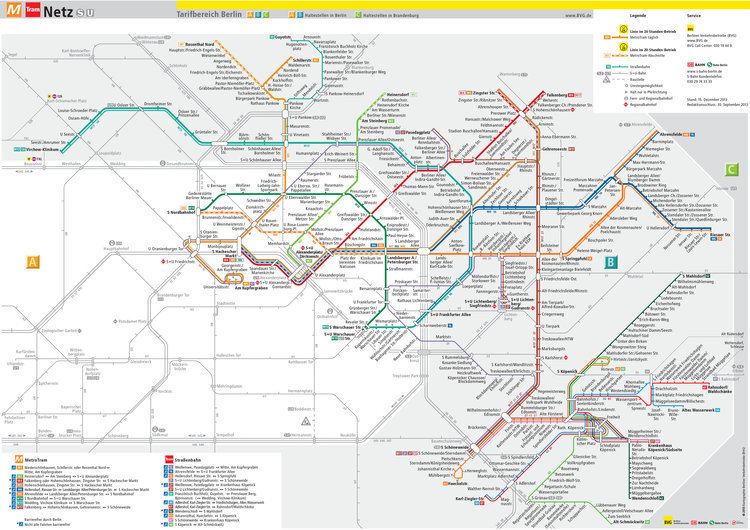
The public transport system of Berlin is the oldest one in Germany. In 1825, the first bus line from Brandenburger Tor to Charlottenburg was opened by Simon Kremser, already with a timetable. The first bus service inside the city has operated since 1840 between Alexanderplatz and Potsdamer Bahnhof. It was run by Israel Moses Henoch, who had organized the cab service since 1815. On 1 January 1847, the Concessionierte Berliner Omnibus Compagnie (Concessionary Berlin Bus Company) started its first horse-bus line. The growing market witnessed the launch of numerous additional companies, with 36 bus companies in Berlin by 1864.
Horse trams

On 22 June 1865, the opening of Berlin's first horse tramway marked the beginning of the age of trams in Germany, spanning from Brandenburger Tor along today's Straße des 17. Juni (17 June Road) to Charlottenburg. Two months later, on 28 August, it was extended along Dorotheenstraße to Kupfergraben near today's Museumsinsel (Museum Island), a terminal stop which is still in service today. Like the horse-bus, many companies followed the new development and built horse-tram networks in all parts of the today's urban area. In 1873, a route from Rosenthaler Platz to the Gesundbrunnen was opened, to be operated by the new Große Berliner Pferde-Eisenbahn (Great Berlin Horse Railway) which would later become the dominant company in Berlin under the name of Große Berliner Straßenbahn (GBS; Great Berlin Tramway).
Electrification
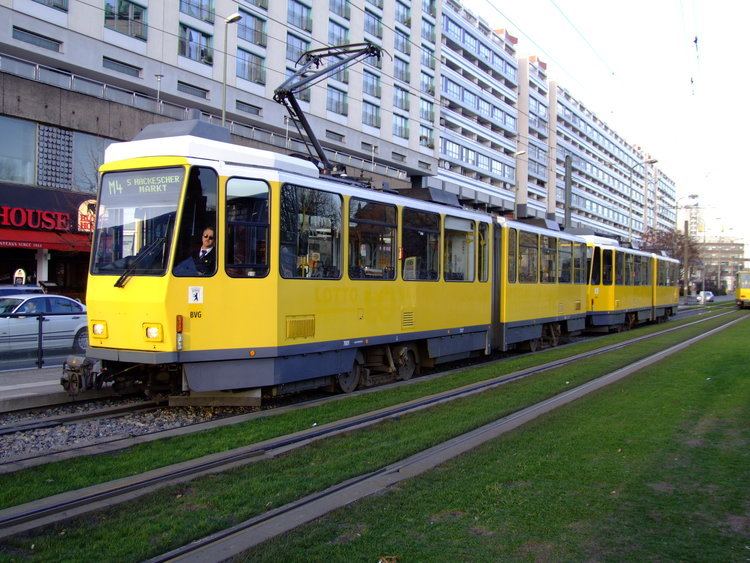
On 16 May 1881, the region of Berlin again wrote transport history. In the village of Groß-Lichterfelde, which was incorporated into Berlin-Steglitz 39 years later, Werner von Siemens opened the world's second electric tramway. The electric tram in Groß-Lichterfelde was built to 1,000 mm (3 ft 3 3⁄8 in) metre gauge and ran from today's suburban station, East Lichterfelde, to the cadet school on Zehlendorfer Straße (today Finckensteinallee). Initially, the route was intended merely as a testing facility. Siemens named it an "elevated line taken down from its pillars and girders" because he wanted to build a network of electric elevated lines in Berlin. But the skeptical town council did not allow him to do this until 1902, when the first elevated line opened.
The first tests of electric traction on Berlin's standard gauge began on 1 May 1882, with overhead supply and in 1886 with chemical accumulators, were not very successful. Definitively, electric traction of standard-gauge trams in Berlin was established in 1895. The first tram line with an overhead track supply ran in an industrial area near Berlin-Gesundbrunnen station. The first line in more a representative area took place with accumulators for its first year, but got a catenary, too, four years later. In 1902, the electrification with overhead wiring had been completed, except for very few lines on the periphery.
The last horse-drawn tram line closed in 1910.
Underground trams
On 28 December 1899, it became possible to travel underground, even under the Spree, upon completion of the Spreetunnel between Stralau and Treptow. Owing to structural problems, it was closed on 25 February 1932. From 1916 to 1951, the tram had a second tunnel, the Lindentunnel, passing under the well-known boulevard Unter den Linden.
Great variety of companies until the formation of the BVG
The history of tramway companies of the Berlin Strassenbahn is very complicated. Besides the private companies, which often changed because of takeovers, mergers, and bankruptcies, the cities of Berlin, Spandau, Köpenick, Rixdorf; the villages Steglitz, Mariendorf, Britz, Niederschönhausen, Friedrichshagen, Heiligensee and Französisch Buchholz, and the Kreis Teltow (Teltow district) had municipal tramway companies.
The most important private operating company was the Große Berliner Pferde-Eisenbahn (Great Berlin Horse Railway), which called itself Große Berliner Straßenbahn (GBS) (Great Berlin Tramway) after starting the electrification. GBS acquired nearly all of the other companies through the years. In 1920, the GBS merged with the municipal companies BESTAG and SSB to become the Berliner Straßenbahn (Berlin Tramway), which was reorganized in 1929 into the newly formed municipal Berliner Verkehrs-AG (BVG) (Berlin Transport Company). Besides the tramway, the BVG also took over the elevated and underground rail lines and the bus routes which were previously operated primarily by the Allgemeine Berliner Omnibus-Actien-Gesellschaft (ABOAG) (General Berlin Bus Corporation).
The following table includes all companies that operated tramways in today's Berlin before the formation of the BVG. The background color of each line marks the drive method which the respective company used to serve their lines at the time of the formation (blue = horse tram, yellow = steam tram, white = electric tram, red = benzole tram).
On the day of its formation, the BVG had 89 tramway lines: a network of 634 km (394 mi) in length, over 4,000 tramway cars, and more than 14,400 employees. An average tram car ran over 42,500 km (26,400 mi) per year. The Berlin tramway had more than 929 million passengers in 1929, at which point, the BVG already had increased its service to 93 tramway lines.
In the early 1930s, the Berlin tramway network began to decline; after partial closing of the world's first electric tram in 1930, on 31 October 1934, the oldest tramway of Germany followed. The Charlottenburger Chaussee (today Straße des 17. Juni) was rebuilt by Nazi planners following a monumental East-West-Axis, and the tramway had to leave. In 1938, however, there were still 71 tramway lines, 2,800 tram cars and about 12,500 employees. Consequently, the bus network was extended during this time. Since 1933, Berlin also had trolley buses.
During World War II, some transport tasks were given back to the tramway to save oil. Thus an extensive transport of goods was established. Bombings (from March 1943 on) and the lack of personnel and electricity caused the transportation performance to decline. Due to the final Battle for Berlin, the tramway system collapsed on 23 April 1945.
The network since 1945
The BVG was—like most other Berlin institutions—split into two different companies on 1 August 1949. Two separate companies were installed, the BVG West in the three western sections (with 36 tram lines) and the BVG Ost (Berlin Public Transit Authority East) (with 13 lines) in the Soviet sector. The latter became in 1969 the VEB Kombinat Berliner Verkehrsbetriebe (BVB). On 14 October 1950, traffic on the lines from West Berlin to the Brandenburgian suburbs Kleinmachnow and Schönefeld stopped, and on 15 January 1953, traffic over the downtown sector border did, too.
From 1949 to 1955, both companies exchanged the Thomson-Houston type trolley poles of their tramcars line by line for pantographs.
West
From 1954 onwards, a shift took place in the public transit plans of West-Berlin. From that moment, plans aimed at discontinuing the tramway service and replacing it with extended underground and bus lines. The tramway was considered old-fashioned and unnecessary since Berlin already had a well-developed underground network. From 1954 to 1962 numerous tram lines were replaced with bus routes and extended underground lines and stops. By 1962, the western part of the city had only 18 tram lines left out of the original 36.
On 2 October 1967 the last tramcar traveled through West-Berlin over the last line, which carried number 55 - from Zoo Station via Ernst-Reuter-Square, the City Hall in Charlottenburg, Jungfernheide S-Bahn station, Siemensdamm, Nonnendammallee, Falkenseer Platz, and Neuendorfer Allee to Spandau, Hakenfelde.
Today, many MetroBus lines follow the routes of former tram lines.
The separation of the city resulted in many problems and difficulties for the public transportation system. Tram lines could no longer travel through the city's center as usual, and the main tram garage was moved to Uferstraße in Western Berlin.
East
Soviet Moscow was, with its tram-free avenues, the role model for East-Berlin's transport planning. The car-oriented mentality of West Berlin also settled in the East since a lot of tram lines closed here as well in the 1950s and 1960s. In 1967, the lines through the city center closed down at the same time as the new city expansion on Alexanderplatz started to grow.
However, complete elimination of the city's tram network was neither planned nor even discussed. In the late 1970s until early 1990s, some new tramway sections were built in order to connect the new housing estates Marzahn, Hohenschönhausen, and finally Hellersdorf to the city's tram network.
After Reunification
In 1992, the West Berlin transport company BVG took over the East Berlin's BVB. (In addition to bus and subway lines, the new BVG also ran the trams, which now only circulated in the former East Berlin districts.)
There was an attempt to shut down the tram routes running to Pankow, because the trams in Schönhauser Allee run parallel to the U2 line, which does not run to Rosenthal, however.
In 1995, the first stretch of tram route along Bornholmer Straße was opened to the west in two stages. The Rudolf-Virchow-Klinikum and the metro stations located in Seestraße, Wedding, and Osloer Straße in Gesundbrunnen have since re-connected to the tram network.
Since 1997, the tram stops right at the Friedrichstraße station. Previously, passengers changing between modes of transport here had to take a long walk to get to the restored train station. Since then, the trams terminate along the reversing loop "Am Kupfergraben" near the Humboldt University and the Museum Island.
The following year saw the re-opening of tram facilities at Alexanderplatz. These routes now come directly from the intersection with Otto-Braun-Straße across the square, stopping both at the U2 underground station and the overground station for regional and commuter trains, where there is a direct interchange to the U5 and U8 lines. The increase of tram accident victims in the pedestrian zone feared by critics has not occurred.
In 2000, the tram tracks were extended from the previous terminus at Revalerstraße past the Warschauer Straße S-Bahn station to the U-Bahn station of the same name. Since there is no room for a return loop, a blunt ending track was established. In order to accomplish this, bi-directional vehicles were procured. However, the tracks, which were further extended in 1995 to the Oberbaumbrücke, have not yet been expanded to Hermannplatz as had been planned long before.
Since 2000, the tram in Pankow runs beyond the previous terminus Pankow Kirche on to Guyotstraße, connecting the local development areas to the network.
In 2006, the second line was opened in the western part of the city, and the M10 line moved beyond its former terminus Eberswalderstraße along Bernauer Straße in Gesundbrunnen to the Nordbahnhof in the district of Mitte.
In May 2007, a new line from Prenzlauer Tor along Karl-Liebknecht-Straße towards Alexanderplatz was put into operation, where the line M2 leads directly to the urban and regional train station instead of the current circulation through Rosa-Luxemburg-Platz to Hackescher Markt. The previous route along Alt and Neu Schönhauser Straße no longer carries regular services but operates only as a feeder line.
On 14 December 2014, MetroTram line M5 was extended from Hackesher Markt S-Bahn station to Berlin Hauptbahnhof via Naturkundemuseum (Berlin U-Bahn) U-Bahn station. This was followed on 29 August 2015 by the extension of lines M8 and M10 from Nordbahnhof to Hauptbahnhof.
Lines
BVG tramway net has 22 urban lines. MetroTram also uses the symbol :
Tram line 68 was named by the National Geographic Society as one of the ten "Great Streetcar routes" worldwide.
Fleet
The Berlin tram has three different families of vehicles. In addition to Tatra high-floor vehicles there are low floor six-axle double articulated trams in unidirectional and bidirectional version (GT6N and GT6N-ZR), and since 2008, the new Flexity Berlin.
The number of trams has shrunk continuously. The BVB had 1,024 vehicles, while currently there are about 600. The reduction is possible because the new low-floor cars on average achieve more than twice the mileage per year (100,000 km) (62,000 mi), and, being longer, carry more passengers and therefore rarely operate in double header.
In July 2006, the cost of energy per vehicle-kilometer was:
GT6N
Between 1992 and 2003 45 bidirectional T6N-ZRs and 105 unidirectional GT6Ns were purchased. The cars have a width of 2.30 m (8 ft) and a length of 26.80 m (88 ft). They can carry 150 passengers and can run as coupled sets.
134 cars were in a risky transaction leased to a US investor and leased back. The SNB has accrued more than €157 million ($205 million) to hedge potential losses from cross-border business.
In the end of 2011 and beginning of 2012 the SNB began the carriage 1006 and 1016 a sample exercise. They were provided with a new drive technology and new software such as the Flexcitys. The only mutually detachable vehicles had to distinguish the new car numbers 1506 and the 1516.
Flexity Berlin
In April 2005, a European tender was issued for low floor trams, half unidirectional, and half bidirectional vehicles. The latter will respond better to the BVG and construction faults and build on certain routes for cost savings. The Vienna tramway tram type ULF was tested in passenger service.
On 12 June 2006, the BVG decided to procure new trams. These are based on the tested Incentro, referred to by Bombardier as Flexity Berlin. In October 2008, for €13 million ($17 million), four prototypes were ordered and since then extensively tested. There are one- and two-way cars, respectively 30.8 (101 ft) and 40 m (131 ft) in length, carrying about 180 or 240 passengers. Use in coupled sets is not possible.
On 29 June 2009, the Supervisory Board of the BVG decided to buy 99 Flexity cars, 40 of which will be long and 59 short versions, for €305.3 million ($397.9 million). In September 2011 the first 13 long cars began to be delivered. To replace all old Tatra cars a further 33 costing €92.3 million ($120.3 million) may need to be ordered in 2017. The trams will be manufactured at Bombardier's Bautzen works or Hennigsdorf.
In June 2012 the Supervisory Board approved the BVG 2nd Serial recall of an additional 39 trams of type "Flexity Berlin." Considering the order over 99 vehicles from 2010, that means a total of 38 vehicles and 47 long bidirectional vehicles as well as 53 short bidirectional vehicles will be ordered from the manufacturer, Bombardier Transportation. Thus the SNB responds to both the very positive development of passenger numbers at the tram and allows bidirectional vehicles the eventual abandonment of turning loops and enhancing the design stops. Once this procurement is secured in 2017, then the old Tatra cars can be scrapped permanently. The State of Berlin's funded budget is €439.1 million ($572.7 million).
The new cars are equipped with 2.40 m 10 cm wider than the existing low-floor trams. The track width was chosen so that modifications in the network are not necessary This affects only the routes, which will operate on the Flexity. Köpenick and parts of the Pankow network, the web is unable to drive.
In December 2015, BVG exercised an option for another 47 Flexity trams from Bombardier to handle increased ridership.
Tram depots
Depots are required for storage and maintenance purposes. BVG has seven operational tram depots, five of which are used for storage of service trams:
Out-of-service trams returning to Nalepastraße and Weissensee depot remain in-service until reaching the special tram stop at each depot.
General view
The Berlin tram network is today the largest one in Germany
Around Berlin there are some additional tram systems that do not belong to the BVG:
The last three companies are located in the eastern suburbs at the eastern edge of Berlin. Each of them has only one line.
